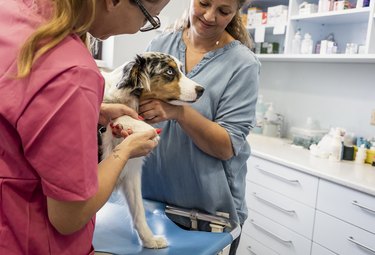If your dog is bleeding from the anus, it can be scary. However, you can take heart that rectal bleeding is often not as harmful to them as it is frightening to you. Assessing your dog's overall condition as well as checking their rectum and anus for clues as to why they are bleeding will indicate whether aid can be administered at home or you need to seek emergency veterinary treatment.

Video of the Day
Approaching a dog with rectal bleeding
An injured dog may strike out from fear or aggression, even your own dog. If they growl or give any warning signals, don't approach them directly and speak softly. Avoid direct eye contact, which they may perceive as a threat.
Video of the Day
Go slow and allow your dog to sniff the back of your hand. If possible, have someone assist you in holding them on their side to check vital signs and examine the rectal area.
Taking a dog's respiratory and heart rate
Just as a doctor takes vital signs before treating a problem, taking vital signs if your dog is bleeding from the anus will help you assess whether the situation is an emergency.
Check the heart rate and pulse if your dog is bleeding from the rectum. The most common place to feel for a pulse on a dog or cat is the femoral area, which is on the inside of the back leg in the inguinal, or groin, region. You can also simply feel the sides of the chest for the actual heartbeat. The normal heart rate for a small dog is 100 to 160 beats per minute. Medium dogs are generally 80 to 120 beats per minute, and large dogs and puppies are variable.
While taking the pulse, check their respiratory rate. Dogs take 10 to 30 breaths per minute but can pant up to 200 times per minute.

Checking a dog's mucous membrane color
Observe your dog's mucous membranes to make sure they are getting enough oxygen. To do this, lift your dog's upper lips and check their gums to make sure they are a healthy pink color; any other colors indicate a serious emergency.
If your dog's gums are pink, press a finger lightly onto the gum and see how long it takes for the color to return (this is known as the capillary refill time, which signals whether blood circulation is normal). It should take one to two seconds to return to pink. Less than one second or more than three seconds indicates an emergency situation and should be handled accordingly.
Finding the source of a dog's rectal bleeding
If your dog is bleeding from the anus and the blood is dark red, it is coming from inside your dog's rectum or digestive system. Bright red blood is a sign that the bleeding is closer to the surface and could be caused by colitis. If blood is only observed in stool samples, note where it occurs.
If the blood is in the fecal matter (known as hematochezia), it's coming from the rectum or digestive system, and if the blood is on the outside of the dog's stool sample, it's from the anus.

Assessing a dog's anal area for bleeding
After vital signs are taken, assess your dog's anal area. The most common reason a dog's rectum may bleed is due to constipation. Check for obstructions and if there is a foreign body or blockage, do not attempt to remove it because the object could penetrate deeper into the intestines, and attempting to remove it could cause irreparable damage to the digestive tract.
Look for signs of parasites, polyps, and tumors, all of which can cause rectal bleeding. Observe the anal sacs of your dog located on each side of the anus. If they appear swollen, the dog's anal glands may need to be emptied.
Responding to rectal bleeding in dogs
If your dog is bleeding heavily, seek veterinary attention immediately. You can do a web search for emergency veterinary clinics in your area if your veterinarian is not available.
If the blood is occasional, minimal, or only observed in the feces, then just monitor the stools daily and speak to your veterinarian for advice on whether or not to try a diet change or make an appointment for potential diagnostics and treatments. If the blood in the stool is occurring along with other signs, such as tarry-appearing feces (known as melena), bloody diarrhea, vomiting, or not eating, seek veterinary care right away.
Also see your veterinarian if bleeding does not clear up within two days. They can perform diagnostic tests, such as blood tests and X-rays of the gastrointestinal tract, to determine the exact cause of the bleeding. In severe cases, your dog might require hospitalization.
The bottom line
Any time a dog has blood coming from their rectum or has bloody stool, it is cause for concern. However, dog owners can find peace of mind knowing that rectal bleeding and blood in the stool does not always indicate a serious pet health issue. Observing your dog as a whole, such as taking vital signs and visually examining the dog's anus, can help determine if this is a veterinary emergency or if home care is appropriate. Always contact your DVM for further advice.